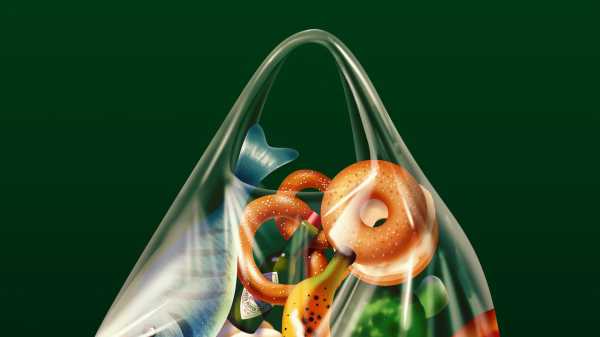
Save this storySave this storySave this storySave this story
“This is shockingly delicious,” a pulmonologist friend and guest at a potluck dinner I hosted a few weeks ago said, as she lifted a third forkful to her mouth. “I’ve never seen anything like it. What is it?”
“Great question!” the comedy writer who’d brought the mystery entrée said. She poked at a striated, gray, pucklike object with a knife. “It looks like meat that archeologists discovered. It came from a food truck on Second Avenue, and it’s vegetarian.” Not much of a clue.
Eight friends and I had gathered that night to save the planet. We probably didn’t save it entirely, but there is a chance that we contributed infinitesimally less than we normally do toward the percentage of earth’s destruction that is caused by food waste. Everything on our dinner table had been obtained by my guests using apps that allow people to buy leftover food from markets, restaurants, bakeries, and other outlets at a discount—in other words, we mostly dined on pre-trash that would otherwise have been chucked. If you think that asking your friends to cater your dinner party seems as nervy as requiring that they bring a house to your housewarming, remember that it’s for a good cause.
The Food Scene
Sign up to get Helen Rosner’s weekly newsletter on what, where, and how to eat.

First, some context to make you despair more: Between thirty and forty per cent of the food supply in the United States is thrown away—by farmers, manufacturers, grocery stores, restaurants, and consumers—making us a world leader in food waste. The discarded goods take up more space and generate more methane than any other material in American municipal landfills. Globally, food waste accounts for almost ten per cent of the world’s planet-warming emissions. In the U.S., forty per cent of this waste comes from grocery stores, restaurants, and food-service companies. Forty-three per cent comes from you. (Relax: I mean the plural you.)
To source the food for my potluck, I’d asked my friends to use the app Too Good to Go, through which one buys “surprise bags” containing unspecified goodies from any of six thousand nine hundred and eighty-seven stores and restaurants in New York City. Shoppers scroll the app and choose a restaurant or store within a certain distance, and then, at an appointed time, pick up the mystery goods. The bags sell for, on average, between $1.99 and $9.99 and tend to be valued at three times that. Too Good to Go (in the U.S.) takes a cut of $1.79 a bag, no matter the bag’s price.
Shopping without knowing what you are shopping for is like going on a blind date, or trick-or-treating. It results in a mishmash of a menu that makes as much sense as one selected by a toddler let loose in a deli. In January, a man in Scotland found that, for the equivalent of $4.20, he’d purchased thirty-six individually wrapped hunks of cheese. Last August, a woman in Chicago opened her Too Good to Go bag and found seven pounds of smashed cake (which she and her friend, the friend confessed, gobbled down). Someone who goes by Cassie Danger on Reddit reported receiving a “corn sandwich” from a Choc O Pain in the Hoboken/Jersey City area, that is, a roll containing a handful of canned corn niblets topped with a couple of lettuce leaves.
As my guests arrived, they spilled their contributions onto my kitchen counter, resulting in a chaotic cornucopia. In the jumble were a teriyaki-salmon bowl, egg rolls, a package of Swiss cheese, plant-based carne asada, a Philly cheesesteak, a chicken-parmesan sub, three slices of pizza, fried rice nuggets, two chicken-and-vegetable curries, lentil soup, a carrot smoothie, sugar snap peas, potatoes, an assortment of such designer fruit as Cotton Candy grapes and Cara Cara oranges, bunches of cilantro and fenugreek, two cabbages, two miniature eggplants, two karela (bitter melon), a foot-long turai (ridged gourd), about twenty-five tindoras (gherkin-size gourds), and tubs of mango chicken salad, macaroni salad, couscous salad, and beet salad. There was also a ridiculous quantity of bread products, including a bag of fifteen bagels, which went untouched. (“The good news about bringing bagels to a dinner party,” a senior at Barnard College said, “is that I can freeze them and bring them to the next dinner party I’m invited to.”)
Bread fun fact: it is, according to at least one source, the most-wasted food in the U.S. Milk is second.
Too Good to Go was founded in Denmark in 2015, and, five years later, it came to America, where it officially operates in twenty-five cities. It now serves ninety-two million users across seventeen countries. Claiming to “save” more than three hundred thousand meals a day, it is the Amazon of leftovers. A recent survey found that fifty per cent of Gen Z-ers in Canada have used a food-waste app, Too Good to Go being the primary one. Some of the other platforms that let you feel virtuous about being a cheapskate include Flashfood, Olio, BuyNothing, and Misfits Market, which began by selling unideal produce, notably blemished and misshapen items, and now sells all sorts of high-quality groceries. Flashfood is known for selling items that are approaching their best-by date but are still safe to eat, at discounts of up to fifty per cent. Olio and BuyNothing are community-based platforms on which members offer their neighbors food and non-food that they want to get rid of—everything from a half-drunk bottle of Diet Coke to an IKEA mirror that needs to be reglued.
As the host-dictator, I assigned one of the four apps to each of my guests, along with Too Good to Go. Rounding out my list of edicts: “There will be no cooking at my house, but microwaving will be permitted if it’s a life-or-death matter” and “If you have food allergies, tough luck.”
Surveying the piles of food, my guests swapped tales of hunting and gathering. One confessed to having conducted a trial run with Too Good to Go a few days in advance, because the timing made her nervous. She was referring to the restricted windows for nearby pickups, which are typically early mornings or late nights, and usually hover around thirty minutes. Time slots are scheduled by the business and can vary day to day. On her test run, she tried Numero 28 pizzeria, in Park Slope, envisioning a pizza dinner at home. At her 8:30 P.M. pickup, she came away with a three-dollar bag of cannoli and donuts. She didn’t mind. “Basically, if it comes to my house, I’ll eat it,” she said. “But my husband preferred a dinner that wasn’t a dessert.” The next day, she hypothesized that, if she reserved a pickup of 2:30, “maybe I’ll get stuff that’s not just old pastries.” She forked over five dollars and found in her bag “like, a hundred and seventy bagels.” It was a good deal, but not a good meal. “If I wanted baked goods made from dough for dinner, it would be a dream,” she said.
The brass ring for Too Good to Go’s users in New York City is Eataly, an emporium of Italian restaurants and marketplace venders with two locations on the app. Its surprise bags go fast, and Reddit is full of frustrated shoppers looking for tips on how to snare one. “The app doesn’t always update. When you know it’s around time, keep clicking on the place,” user Kvsav57 writes. “You need to have your payment method saved and ready to purchase. Mine auto buys with my fingerprint,” N3RD_01 says. (When scrolling through the stores with available surprise bags, only one guest said she saw Eataly on the list. Apparently the slots are often filled microseconds after being listed, and the listing times are inconsistent.) According to the lucky winners, Eataly’s bags contain anything from focaccia and walnut sauce to what a Redditor called a “severely dented” can of San Marzano tomatoes.
But the offerings vary widely. You can get bags from Morton Williams supermarkets (carton of Egg Beaters, anyone?) or Juice Press (any takers for vanilla-oat-milk cold brew?). And some of the most popular food at my party came from the DF (Divine Flavored) Nigeria Food Truck (how about peppered cow skin?) owned by the chef Godshelter Oluwalogbon, a.k.a. Divine, parked outside the Nigerian consulate on Second Avenue.
One of my guests, an English and economics major at Columbia, had no luck with Flashfood, which partners with chain stores. Users get to choose which items to purchase (no surprises) and can pick up their orders at any time during store hours, in an on-site Flashfood zone. But Flashfood has no Manhattan locations and is limited to Stop & Shops in the Bronx, Queens, and Brooklyn. The student said, “The two stores I could have possibly made it to had about twenty offerings—things like ankle of veal and other cuts of meat I wouldn’t know how to cook. I could have gotten milk, but I don’t know if I want to be getting milk on sale.”
Over the phone from San Francisco, Flashfood’s chief customer officer, Jordan Schenck, told me that the app caters to the “low- and fixed-income customer” (Flashfood accepts E.B.T. card payments from SNAP beneficiaries at some stores) and also to the “community that is into the playfulness of experiencing food abundance.” By that, she said, she meant the customer who delights in “spending three days figuring out what to do with the twelve pounds of sausage they bought for eleven dollars in the Bronx.”
My Columbia friend had better dinner-party luck with Too Good to Go, snagging a $4.34 container of chicken shawarma and rice (retail: $14) from Zurna, a Mediterranean restaurant on 104th and Broadway. And from Subs Conscious, a sandwich shop on Amsterdam Avenue at 120th Street, he picked up a chicken-parm sub for $6.53 (retail: $9.25). (“They didn’t know what was in the container, but they were super nice,” he said.) But he, too, mentioned the timing issue: “If you don’t want to pick up after the restaurants close, you end up carrying your dinner food around for four hours, which is fine.”
“Fine for bacteria!” another guest chimed in. Not to mention a soggy sub roll.
Speaking of bacteria, a word about “best if used by” labels. The suggested dates are recommendations, not legally binding edicts, and they pertain to peak taste, not safety. In Denmark (and some other European countries), a few brands, hoping to reduce the amount of food thrown out unnecessarily, teamed up with Too Good to Go to put the label “Ofte God Efter”—“Often Good After”—on products, including beer, milk, and chocolate. Food dating is not required by U.S. law, except for baby formula, and there are no federal guidelines. As with speed limits, most gun laws, and whether you say “sub” or “hero” or “grinder” or “hoagie” (go hoagie!), when it comes to food labels, it’s every state for itself. Manufacturers get a say, too. Feel free, then, to use the “Does this smell funny to you?” rule. To that, may I add that a bad color for milk is plaid?
One more tidbit about Denmark before returning to my dining room: One Danish supermarket chain, troubled by how many lone bananas got thrown out at the end of each day, tackled the problem by sticking labels on them that said, “Take me, I’m single.” Banana waste was reportedly reduced by ninety per cent.
Introverts would be wise not to join the seven and a half million members of BuyNothing or the 7.7 million members of Olio. These two platforms are based on the premise that what is mine could be freely yours and vice versa. Their modus operandi is giving and taking and kibbitzing. The friend to whom I’d assigned BuyNothing sent me an e-mail with snapshots of the offerings—a pair of snorkels and a dozen packages of frozen chicken and duck dog food—along with a note saying, “An Ayn Rand nightmare.” (“We exist to build resilient communities where our true wealth is the connections forged between neighbors,” the company’s Web site proclaims.)
Olio calls itself the “feel-good sharing app.” A dinner-party guest found only one food item on Olio: a box of gluten-free pancake mix 7.1 miles away. Among the items proffered by Nextdoor, another hyperlocal social-networking platform, was a discounted half-bag of hamster bedding from someone whose hamster had just died—a listing that seems to call for a condolence note.
The roots of the food-waste movement go back to gleaning, the ancient practice of collecting crop scraps left on farm fields after the harvest. One difference is that gleaning is mandated in the Bible (“When you reap the harvest of your land, do not reap to the very edges of your field or gather the gleanings of your harvest. . . . Leave them for the poor and the foreigner. I am the LORD your God,” Leviticus 19:9-10), where food apps are not mentioned. Since the passage of the Bill Emerson Good Samaritan Food Donation Act, in 1996, the United States Department of Agriculture has encouraged individuals and corporations to glean by protecting them from liability if the goods cause harm.
The online grocery store Misfits Market is so-named because it does not discriminate against ugly produce. Conjoined tomatoes? Rhubarb-shaped chard? Pea-size watermelon? A pear in need of a butt lift? All are placed in loving homes, by delivery people that come once a week. The fact is, most of the produce is perfectly lovely. I prayed that we’d see Jesus’ face in a melon rind, but we were not so blessed. “When I got the lettuce, I expected worms to come out, but it was fine,” one of my guests said. The fruit she ordered—organic Fuji apples, mandarin oranges, Cotton Candy grapes—were “suspiciously perfect,” she said. “It must have had major cosmetic surgery en route to me.”
At the dinner party, after the food containers had been unlidded and the bagged treats dumped into bowls, the carbo-loading began. Like all buffets, this one seemed to bring out the glutton in everyone. (Scientists blame the instinct on “ingestion analgesia,” the suppression of negative feelings that occurs while we eat, which leads us to keep eating in times of plenty, even when full—a survival strategy to withstand times of scarcity.) Many guests went back for seconds. Aside from the Nigerian food (rated a six out of ten by several guests), what was a hit? The desserts, especially the assortment of giant pastries from the bakery-café chain Maman, whose bags on Too Good to Go are almost as prized as Eataly’s. The group rhapsodized about the croissant filled with custard cream and topped with crushed pistachios, and one person singled out “this peanut-butter-and-jelly situation that I highly recommend.”
As we digested, we debated whether the apps make a difference. Forget for now the not-insignificant spoilage that takes place at the production level on farms (because of crop pests, inadequate storage and refrigeration, labor shortages, and so on). What about the eighty-five per cent of unused food in restaurants and the thirty per cent of surplus groceries from stores that apparently end up in the garbage?
I texted William Masters, a professor of food economics and policy at Tufts University, to ask what he thought about food-waste apps. He sarcastically replied, “Kudos to them for making leftover clearance items more valuable.” In other words, the critics say, these apps exaggerate their environmental and humanitarian impacts. Others argue that by turning excess food into commodities, the apps diminish the incentive of restaurants and retailers to make supply align with demand and to give their remainders to nonprofits that donate food to the needy.
Baylen Linnekin, the author of “Biting the Hands That Feed Us: How Fewer, Smarter Laws Would Make Our Food System More Sustainable,” has a different view. “The fact that these apps help raise awareness of the problem puts a small dent in over-all global food waste—and that they help some people buy cheaper food—has to be a net positive,” he told me over the phone.
The party’s over. Total cost to overfeed nine people: two hundred and forty-four dollars (not including the wine and butter I contributed, the latter to keep the mountain of untouched bread products company). Number of converts to the food-waste-app cause: one, who said that she’s going to use Too Good to Go because it will allow her to try different restaurants and because “the idea of someone wasting a good babka just breaks my heart.” Three of my testers had used the apps before the potluck and will continue to do so. As for the others, they offered a variety of reasons for opting out:
“The only thing worse than eating semi-stale bagels at 8:40 P.M. is having to spend the day worrying that your surprise bag won’t contain any bagel flavors you like.”
“I’m suspicious of getting food that is bad or makes me sick, and I’d rather pay a little more to get food I’m confident about.”
“In the name of saving money, the apps incentivize you to buy five times as much of something as you would ever use.”
After my guests left, toting their bulging doggie bags, there were still leftovers left over for me—a lot of apples, a container of beet salad, the chicken-parm sub. Throwing them out felt as wrong as returning a rescue dog to the kennel. I carefully packed everything into airtight containers, stuck them in the back of my refrigerator, and a few days later, when I’d got over my guilt, dropped it all down the trash chute. ♦
Sourse: newyorker.com







